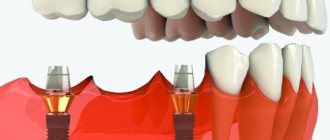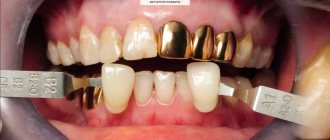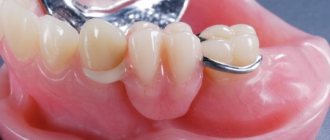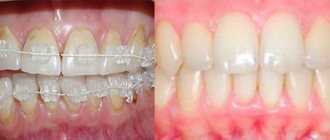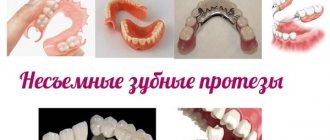01/22/2019 Modern dentistry offers various methods for correcting chips, cracks and other dental defects. One of the popular solutions is extension, which allows you to return the tooth to its original color and shape. What the procedure is and who it is suitable for - you will learn about this from our article.
- What is tooth augmentation?
- Indications and contraindications for the procedure
- Advantages and disadvantages of dental extensions
- Basic methods of filling
- Installation of veneers
- Installation of crowns
- Extension on a pin
What is tooth augmentation?
Dental augmentation is a dental procedure that allows you to restore the appearance of teeth and restore their lost functionality. A type of extension is artistic restoration - a technique for restoring the front teeth.
Both procedures are performed using special materials that are visually similar to the texture of natural enamel. The restored unit has the same shade and texture as natural dental tissue, is highly durable and lasts for at least 10 years.
Ceramic crowns for teeth
Metal-free crowns are deservedly recognized as the most aesthetic: they are extremely difficult to distinguish from natural teeth, even if the gum tissue becomes thinner, the prosthesis remains invisible and looks natural. In dentistry, several types of metal-free dental crowns are used:
- Porcelain or all-ceramic. They are made according to a personal impression from pressed material without adding other components.
- Mixed (zirconium dioxide and ceramics). They are stronger than the previous type of prosthesis, have high light transmittance and do not cause allergies.
- Mixed (aluminum oxide and ceramics). The designs are made of translucent hypoallergenic material, which is comfortable to wear and resistant to temperature changes.
All ceramic products are biologically compatible with mucous membranes and do not tend to cause allergic reactions. Other advantages of the designs include:
- light weight (a crown can be installed even on weakened teeth);
- immunity of ceramics to dyes;
- the need for minimal tooth grinding before ceramic prosthetics.
The disadvantages of this method of prosthetics include the relatively high cost of the products, as well as their fragility. Ceramic structures are not designed for significant chewing loads, which is why they are more often used for prosthetics of the upper incisors.
If you properly care for ceramic products, they will last from 10 to 15 years. At the same time, the prosthetic structure is not susceptible to caries and does not accumulate plaque.
Indications and contraindications for the procedure
Extension is indicated in the following cases:
- Chips and cracks on the tooth surface.
- Destruction of enamel or its discoloration, which cannot be eliminated with bleaching.
- Partial tooth loss due to injury or caries.
- Malocclusion.
- Interdental gaps.
- Age-related wear of enamel, in which the dental unit darkens and becomes sensitive to external influences.
However, restoration is not suitable for every patient. It cannot be performed if one of the contraindications is present:
- Untreated caries or gum disease.
- Severe systemic diseases, such as blood diseases or diabetes.
- Some mental disorders.
- Bruxism.
- Bruxism. Individual intolerance to the components of the filling composite.
There are also technological limitations: if it is impossible to protect the restored surface from contact with moisture (for example, saliva), then the extension will have to be abandoned - the filling will not harden. Also, some methods cannot be used for dental treatment in children - for example, they do not have pins installed. For most patients, augmentation remains the optimal solution for restoring a lost tooth fragment.
Gold crowns on teeth
Separately, it is worth noting the type of metal crowns - gold products. In dentistry, pure material is not used in the manufacture of dentures, since gold is a soft metal. Traditionally, an alloy with palladium and platinum is used. The structures fit well, do not irritate the mucous membrane, and do not lead to bleeding gums.
Very often, gold dentures are coated with a ceramic layer. Such products can even be placed on the front teeth: they retain the beneficial properties of the base material and look good.
Advantages and disadvantages of dental extensions
In dentistry, various methods are used to restore lost tooth fragments, but for most patients, doctors recommend paying attention to tooth extensions. This is due to the numerous advantages of the procedure:
- A large selection of technologies and materials allows you to choose the optimal solution for each person and restore both front and back teeth.
- Highly aesthetic results.
- The restoration does not affect neighboring (healthy) units, does not increase the chewing load, that is, it protects the dentition from accelerated wear and destruction.
- Minimal trauma: oral tissues heal quickly without causing significant discomfort to the patient.
- The materials used during extensions are durable, aesthetically pleasing, do not change color and strength during use.
Dental extensions have virtually no disadvantages. The only drawback is the fairly high cost of services, but it can be adjusted by choosing simpler restoration methods and more affordable materials.
Metal-ceramic crowns
Practice shows that metal-ceramic crowns are deservedly considered the most popular. The base of the product is metal (cobalt, chromium, titanium, gold, etc.). To give the crown an aesthetic appearance, the metal base is covered with a ceramic layer and the elements are connected by exposure to high temperatures.
The popularity of metal ceramics in prosthetics is explained by its obvious advantages:
- Aesthetics. The material with which the crown frame is covered completely recreates the anatomical structure of the enamel;
- Sufficient strength. The products are quite durable due to the cast metal frame - they can withstand normal chewing loads and do not wear out. It is rare to see chipping of the enamel coating. In this case, repair of the prosthesis can be done in the patient’s mouth;
- Versatility. Crowns of this type are installed both on individual fragments of a row, and in the form of a dental bridge.
Since the ceramic layer is completely opaque, the prosthetic fragment (especially with a single restoration) can stand out against the background of natural teeth. Another disadvantage of metal-ceramic crowns is the need to grind the unit, after which it forever loses its original shape.
Basic methods
There are several methods of teeth extension, differing in technology, compositions used, and price. The main methods include:
- Filling.
- Installation of veneers.
- Installation of crowns.
- Extension on a pin.
Each method has its advantages and disadvantages, which are discussed below.
Sealing
Filling is one of the simplest and most affordable ways to build up a tooth, provided that the bone tissue is preserved. The dentist selects a shade of the composite that is as close as possible to the patient’s natural enamel color. Then the composition is applied layer by layer to the dental unit, resulting in the formation of a monolithic structure with a tooth. The filling hardens under the influence of light - it quickly gains strength and practically does not wear out over time. The top layer is sanded and varnished, due to which it most accurately replicates the natural relief of dental tissue.
The main advantages of filling:
- Nerve preservation.
- Possibility of restoration of both minor defects and severe damage.
- High speed of the procedure - you can restore a tooth in one visit to the dentist.
The disadvantages include the fact that the aesthetics of the restored tooth directly depends on the skill of the dentist, who must give it the most natural shape possible. There is almost always a risk that the filling will look less natural than the “native” hard tissue of the unit.
Installation of veneers
Another way to build up your teeth is to install veneers. They are thin porcelain microprostheses that imitate the front surface of a tooth. Overlays allow you to hide discoloration, signs of enamel destruction, chips and make your smile attractive.
The service life of the plates is 10-15 years, during which they do not change color even with frequent consumption of coloring products (berries, wine, coffee). But dental porcelain can crack under high loads and direct impacts.
Before installing the veneer, the tooth is prepared - the top layer of enamel is removed. Then a plate is applied and fixed with dental cement. This extension technology is used to restore only the front teeth. Among the main advantages of the technique are:
- High aesthetics.
- Long service life of structures.
The disadvantages include the need to remove the top layer of enamel. This can be avoided by installing lumineers - even thinner microprostheses that are fixed directly to the tooth surface without preliminary preparation (grinding).
Installation of crowns
Crowns are metal, ceramic or metal-ceramic caps that imitate the surface of one or more dental units. Installing crowns allows you to compensate for serious defects - for example, chips or the complete absence of several teeth, and restore beauty and functionality to your dentition.
The denture is made in a dental laboratory using a previously taken impression, so it fits the patient perfectly. Before tooth augmentation, the oral cavity is sanitized, nerves are removed, and the units on which the crown will be placed are turned. The procedure requires multiple visits to the dentist.
Modern crowns made of ceramics and metal-ceramics restore aesthetics to the smile. The material imitates the shade of enamel, does not absorb food coloring, and does not wear out during use. The service life of crowns depends on the manufacturing technology and averages 10 years or more. The main advantages of this extension technique:
- Possibility of restoration of both anterior and chewing teeth.
- Restoration of dental units with partial or complete edentia.
- Highly aesthetic results.
Among the disadvantages is the fairly high cost of the procedure. However, the price can be reduced by using more affordable materials in the crown manufacturing process.
Extension on a pin
Extension on a pin or pinning is recommended by the dentist if the hard tissues of the tooth are destroyed, but the root is not damaged. During the procedure, a rod is screwed into the jaw, onto which a temporary crown is placed.
After the surrounding tissue has healed, the temporary crown is replaced with a permanent one. Advantages of this extension method:
- Possibility of restoration of both front and back teeth.
- A wide variety of post materials allows the patient to influence the cost of the restoration towards its reduction.
- Long implant lifespan.
The disadvantages usually include the need to restore tissue after implantation of the rod, during which a person experiences some discomfort (inflammation and swelling of the gums). Another disadvantage is the relatively high price of pin extensions.
Restoration of teeth using filling materials
Step 1. First, an impression of the front teeth is made, according to which the build-up with composite materials will be carried out. After this, the doctor, using special equipment, grinds the teeth down to a certain level.
Creating a cast
Grinded teeth
Step 2. Having protected the remaining teeth, the dentist treats the already ground teeth with a liquid composition, after which it hardens under the influence of ultraviolet rays.
Treatment of ground teeth with a liquid composition
Step 3. An impression is made of the teeth so that the shape of the tooth can be recreated from it. The procedure is performed extremely carefully; the doctor covers the side part of the tooth being restored with special dental onlays. During the filling process, an ultraviolet lamp is periodically used to harden the composition used.
Impression attached
Step 4. When the tooth is almost ready, its surface is treated with a protective substance that can protect the extended tooth from harmful factors (such as food, drinks, smoking, and so on).
Application of a protective composition
Step 5. As a result, the patient leaves the dentist’s office with a new snow-white smile. Moreover, this does not require much time - just one visit is enough to completely build up the front teeth.
Teeth after restoration
Choosing a teeth extension technique
You can choose the optimal method of tooth extension only after consulting a dentist. The doctor will assess the degree of destruction of the dental unit, check the safety of the root and nerve, and depending on this, recommend a suitable method of restoration.
For example, veneers or lumineers are most often used to restore minor damage to incisors and canines. They hide visual defects, straighten the dentition, and return lost whiteness to the unit.
If the hard tissues of the tooth are seriously damaged, then you should resort to crowns or extensions to a pin. In this case, you can completely restore the unit and return it to functionality.
When consulting with a dentist, you need to clarify:
- The service life of the restored tooth, its resistance to wear, food coloring, and the possibility of restoration in the event of a chip. For example, some crowns can be repolished if minor defects appear; reinstallation of the microprosthesis is not required.
- The number of procedures for which it will be possible to grow a tooth. The fastest options are filling and installation of lumineers. Other technologies will require multiple visits to the clinic.
- Tissue healing rate. Some augmentation methods allow you to restore a tooth without damaging the gums. This guarantees the patient minimal discomfort after the procedure.
Different types of extensions differ in price, which must be taken into account when choosing a technique.
Caring for an extended tooth
Patients who have had to have a tooth augmented need to carefully follow the rules of oral care and also get rid of some bad habits [1].
First, you should avoid eating solid foods, such as nuts, hard cookies, crackers, and candies. In addition, you need to get rid of the habit of chewing a pencil or pen.
Secondly, do not forget that composite materials can be painted more easily than enamel, which means you should avoid brightly colored drinks such as coffee and tea, fruit and berry juices, and red wine. Smoking can also ruin the color of your extensions. It is especially important to follow this rule during the first days after the procedure [1].
Thirdly, it is necessary to follow the general rules of oral hygiene: brush your teeth at least 2 times a day, use a soft-bristled toothbrush, toothpaste and mouth rinse with fluoride, as well as dental floss to clean the interdental spaces.
Fourthly, it is important to visit the dentist at least once every six months, not forgetting the importance of regular professional cleaning procedures. You should know that restored teeth need especially careful polishing.
If you notice an unpleasant sensation in the mouth at the site of the restored tooth, for example, a scratching edge or a suspected chip of the composite material, you should immediately contact your dentist for an examination.
Cost of procedures
Prices for dental extensions vary depending on:
- Number of units restored.
- Severity of the defect.
- The chosen extension technique.
- Materials used.
The cost is also affected by the condition of the oral cavity, the preservation of the tooth root, the need for preliminary sanitation and other procedures. The final price of services is determined after examination by the dentist. The patient can influence the final cost by choosing more affordable composites and restoration technologies.
Regardless of the chosen technique, the doctors at the Ulybka dental clinic guarantee their patients beautiful and long-lasting results. Our specialists have extensive experience in building extensions of varying complexity, have modern tools and use advanced materials to ensure a highly aesthetic result.
You can find out the cost of extension of front and back teeth in Yoshkar-Ola in our price list.
Which restoration method to choose?
There is no clear answer here for obvious reasons. It all depends on the degree of damage that the crown and root have. If we talk about the direct method, it is as gentle as possible, since its implementation does not require first removing the nerves. The composite material is applied to the crown in layers. At the same time, the tooth is still “alive” and is able to perform its original functions.
It is not possible to use the indirect method without first removing the nerves. An orthopedist implants inlays and pins into the root canals of a tooth with a dead nerve, after which a layer-by-layer application of composite material is performed. If the patient has significant damage to the crown, this extension option is the only possible one.
Temporary crowns on teeth
Since dental prosthetics requires time, the patient is often given temporary crowns. The patient wears the dentures until the permanent dentures are ready.
We are talking about inexpensive polymer, acrylic, and plastic crowns, which are designed to protect the prepared units from displacement and pathogens. In addition, they perfectly perform an aesthetic function, masking “holes” in the oral cavity.
Temporary crowns can be placed on natural teeth or on implants. Due to these structures, an even distribution of the chewing load is ensured, the risk of jawbone resorption is reduced, and the rate of adaptation to a permanent prosthesis is accelerated.
How much does it cost to install a crown on a tooth?
The key criterion that determines the cost of prosthetics is the material used to make the prosthesis. If you arrange them from cheapest to most expensive, the list will look like this:
- metal-plastic;
- metal;
- gold;
- metal ceramics with ordinary metals;
- metal ceramics on a gold base;
- ceramics;
- zirconium dioxide.
In addition to the material, the price of the prosthesis is also influenced by the pricing policy of the clinic, the equipment used, and the qualifications of the attending physician. Some clinics manage to save money on prosthetics by installing crowns on several teeth at once.
It is impossible to accurately answer the question of which crown is best to install. The doctor makes the decision together with the patient. When choosing, emphasis is placed on clinical indications, characteristics of the patient’s jaw system, the state of oral health in general, the wishes and financial capabilities of the person.



